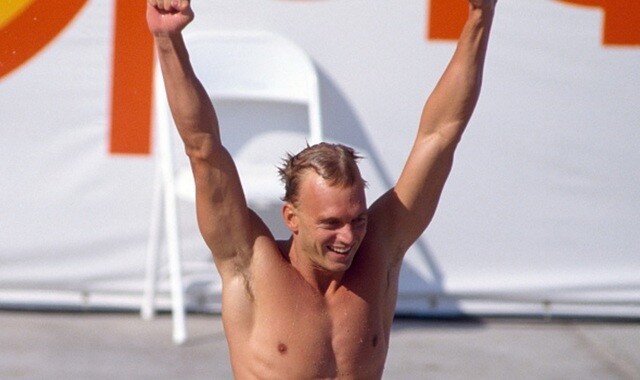Over 100 LDS athletes have competed in the Olympics, with five competing in the 2018 Winter Olympic Games. While many stood for their faith while they made history, there are some who were still searching for truth when they showed up on the world stage.
Here are a few famous Olympians who converted to the LDS Church.
Ambrose Gaines IV
Ambrose Gaines IV, better known by his friends as "Rowdy," was one of the world’s fastest swimmers in the 1980s.
A 22-time NCAA All-American who broke several world records from 1978 to 1984, no one would guess Gaines had a rough time with sports as a boy—that is, until he tried swimming as a junior in high school.
In the 1980 Moscow Olympics, Gaines was predicted to win no less than five gold medals up until the United States decided to boycott the Olympic Games.
Thinking his Olympic run was over, Gaines retired shortly after graduating from Auburn in 1981. But when Gaines’s father encouraged him to keep swimming, he recommitted himself to the sport, and within a year he broke his own world record in the 200m freestyle at the World Championships.
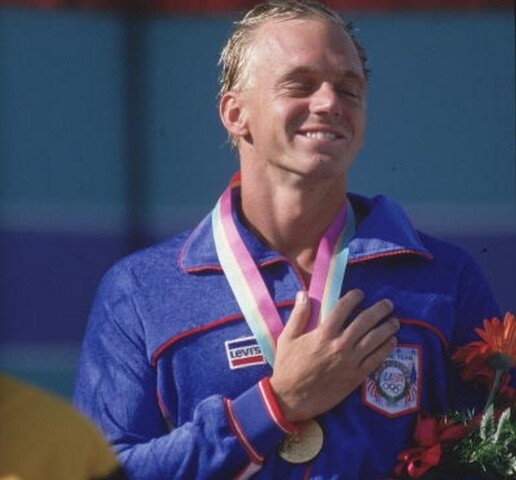
At the 1984 Los Angeles Olympic Games, Gaines returned to the spotlight, winning three gold medals—the most of any swimmer that year. But Gaines didn’t keep the glory for himself. Instead, he gave away each of his medals, one to his coach, one to his dad, and one to his mom.
In 1989, Gaines met and married Judy Zachea, a convert to the Church who was not active at the time. The two had just begun building their new family together when, in 1991, Gaines struggled with unexpected health problems. He was diagnosed with Guillain-Barre Syndrome, a rare disorder where the body’s immune system begins attacking the nerves. Weakness, tingling, and eventual paralysis are common symptoms.
Around the time of his diagnosis, an LDS friend invited the Gaines family to attend church. Soon after his recovery, Judy and Rowdy took the offer and began attending church with their family.
His daughter was the first to be baptized in 1998. According to the Church News, Gaines spoke at her baptism about the gift of the Holy Ghost. “He said, 'Madison, one thing I cannot buy for you is the gift of the Holy Ghost,'” Judy Gaines recalled. “Then he got choked up and couldn't speak. The Spirit was so incredibly strong."
Just two weeks later, Gaines joined his daughter and was also baptized a member of the Church.
Thanks to his incredible fitness, determination, and newfound faith, Gaines was able to make a full recovery. In fact, in 2011 he broke yet another world record at the Masters for the 50-54 age group in the 100m free.
Now ranked as the most experienced television swimming analyst, Gaines makes frequent appearances as a commentator during the Olympics. In fact, you’ll have a chance to hear him this year at the Rio 2016 Games.
But, when asked what his proudest accomplishment is, this father of four girls told the Church News: “There's no comparison. It doesn't even measure on a Richter Scale . . . A gold medal is worthless compared to the love I feel for my family. It may sound corny, but it's true."
Mark Schultz
“One of the greatest, if not the greatest, all-around athletes that has ever participated in the sport of wrestling. As wrestling machines go, his design is close to perfect."
That's how 16-time National Wrestling Champion Wayne Baughman described Mark Schultz. Born October 26, 1960, in Pala Alto, California, Schultz was the second son born to Dorothy and Philip Schultz. His older brother, Dave, was just 17 months older than him.
Growing up, Schultz was an all-around athlete, setting 20 school records. As a sophomore in high school, he became the Northern California All-Around Gymnastics Champion. However, Schultz followed in his big brother's footsteps, taking up wrestling in his junior year.
Though his brother, Dave, won the state, national, and international titles in his senior year, Mark had a mediocre first year of wrestling. However, Shultz's skill improved, and as a senior he won the state title.

Mark Schultz at the 87th Academy Awards.
In college, Dave and Mark teamed up together to train which greatly improved Mark's skill, allowing him to win three NCAA Championships. The Schultz brothers became the most-winning brother combination in American history when it came to NCAA, US Open, World, and Olympic titles. They also became the only American brothers to win World Championship and Olympic gold medals.
Dave won the 1983 World Championship and brought home an Olympic gold medal for the 1984 Games. Mark won his Olympic gold the same year, 1984, and the World Championships in 1985 and 1987. He retired from wrestling after placing sixth in the 1988 Olympic Games.
In the 1980s, Mark was short on money. He'd just lost a job as an assistant wrestling coach at Standford and USA Wrestling didn't pay its athletes. So when a multimillionaire, John du Pont, approached Mark to join a wrestling program at Villanova University that would pay $24,000 a year and give Mark a home on du Pont's 800-acre Foxcatcher estate, Mark took the job. Later Dave joined his brother on the du Pont estate, despite du Pont's sometimes violent outbursts and many oddities.
Eventually, Mark left Foxcatcher, and in 1991, Mark Schultz began working as BYU's assistant wrestling coach where he became a convert to the LDS Church.
Then, suddenly, while training for a second Olympic bid in 1996, Dave Schultz was shot three times by John E. du Pont in his home at Foxcatcher Farm, dying in his wife's arms. Mark had suddenly lost “his best friend . . . and life-support system," Nancy Schultz told The Guardian.
It was only with the help of his LDS faith that Mark was able to overcome the hatred and anger that built inside him after his brother's murder. “My anger over time has turned to pity and my pity has turned into compassion for John,” he says. “I feel like I’ve gotten to understand him better, as odd as that sounds about a man who murdered my brother. I can forgive him,” he told The Guardian.
At the time, Mark was the head coach of Brigham Young University's wrestling team. And just four months after Dave's death, Mark competed in the Ultimate Fighting Competition IX, winning $50,000 and the competition.
The emotional and exciting details of Mark Schultz's life caught the attention of Director Bennett Miller, who captured it in the film Foxcatcher starring Channing Tatum as Mark Schultz, Mark Ruffalo as Dave, and Steve Carell as John E. Du Pont.
Antje Misersky Harvey
Antje Misersky grew up behind the Iron Curtain as an East German cross-country skier.
When the German national cross-country team kicked her off the roster when she refused to take steroids, Misersky’s family became a target of government scrutiny and the teenager thought her Olympic dreams were dashed.
That is until she discovered the biathlon, an event that not only took her to the Olympics but also led her to her future husband.
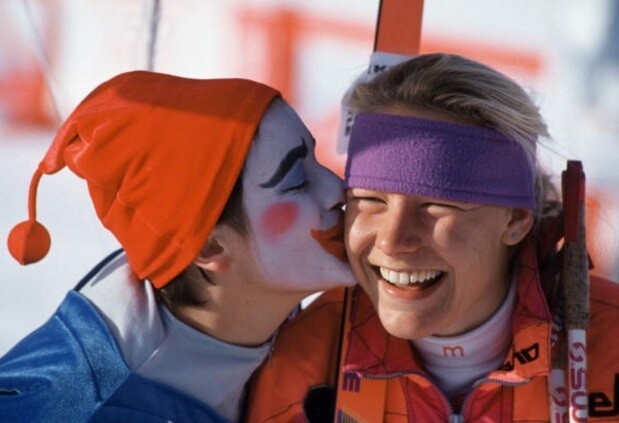
Three years after the Berlin Wall fell, Misersky competed in the 1992 Albertville Winter Olympics, earning one gold medal in the 15 km race and silvers for the 7.5 km sprint and 3 x 7.5 km relay. During this time, she and her father—a former head ski coach in East Germany who was fired when he refused to give his athletes steroids—spoke out against the East German team’s history of doping, something that garnered both respect and notoriety as well as death threats and an unpopularity in East Germany.
During the 1991-92 Biathlon World Cup in Ruhpolding, Germany, Misersky met American biathlete Ian Harvey, and the two were married 15 months later.
In 1994, Antje Misersky Harvey appeared in the 1994 Lillehammer Winter Olympics, this time bringing home a silver for the 4 x 7.5 km relay.
After the birth of her two daughters, Hazel and Pearl, Antje began suffering from hyperthyroidism. During this time, a neighbor tried to help Antje by teaching her about the Atonement. Soon after, Ian and Antje began reading the Book of Mormon together and later were baptized as members of the Church.
In 2012, Antje and her father were inducted into the Hall of Fame of German Sports.
Robert Detweiler
Before becoming a colonel in the United States Air Force and a member of the Church, Robert Detweiler grew up in Zeigler, Illinois.
After graduating from high school in the 1940s, Detweiler attended the U.S. Naval Academy where he became a member of the school’s rowing team. Known as the “Great Eight,” his team is considered the finest in the history of the sport. They never lost a single race, including when they took gold at the 1952 Helsinki Olympics.
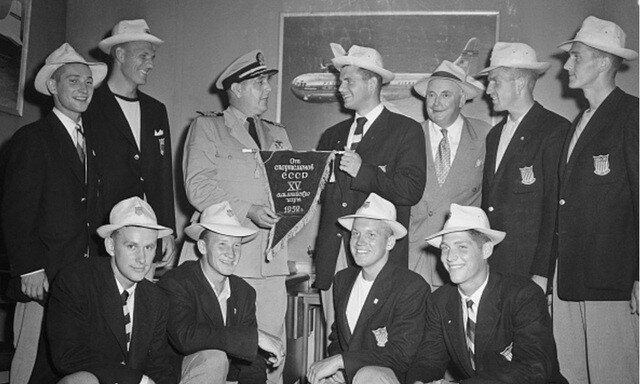
Robert Detweiler, center, presents a banner from the Soviet Union to Captain Ian C. Eddy, surrounded by the rest of his eight-man rowing crew.
A year after his Olympic victory, Detweiler graduated from the U.S. Naval Academy and became a pilot in the Air Force, serving 26 years and earning five Distinguished Flying Crosses, the Legion of Merit, and the Distinguished Service Medal. Detweiler also became a nuclear physicist and was named "The Most Outstanding Military Scientist" in 1965.
During this time, Detweiler began investigating the Church and was later baptized. In 1978 he married Donnell Brown in the Idaho Falls Temple. During his years as a member, he served faithfully in a number of callings, including a bishopric counselor, temple ordinance worker, and Scout leader.
Among his many jobs, Detweiler served as the Director of Research for energy and communications at Eyring Research Institute in Provo.
A man of many talents, Detweiler also served as the Director of Research for energy and communications at Eyring Research Institute in Provo, became a founding member of the Utah Piano Quartet, sang with the Salt Lake Opera Company, and served as chairman of the Utah County Arts Council.
Jean Saubert
Jean Saubert's journey to join the Church starts with the story of Latter-day Saint Marvin Melville. Skiing was simply an exciting diversion and outlet for Melville as a boy, but after beating former Olympic racers to win the 1955 Snow Cup, he suddenly realized that skiing could be more than a hobby.
Melville was selected as one of the four starters on the U.S. eight-man ski team headed for Cortina, Italy in 1956. And though he never earned amedal in the Games, his impact on the Olympics was far from over.
In 1964, Melville was asked to be the assistant coach for the U.S. women’s ski team. That’s when he met Olympian Jean Saubert for the first time. An Oregon native, skiing didn’t come naturally to Saubert like it did Melville. "I lost lots of races—I was third all the time because there were usually only three of us [competing]," Saubert told LDS Church News with a laugh.
Despite her struggles in the sport, Saubert’s painstaking determination led her to win junior nationals at 14. By age 21, she was the U.S. team’s top female slalom skier and a medal favorite.
“She was the best in the world in the slalom," Melville told LDS Church News.
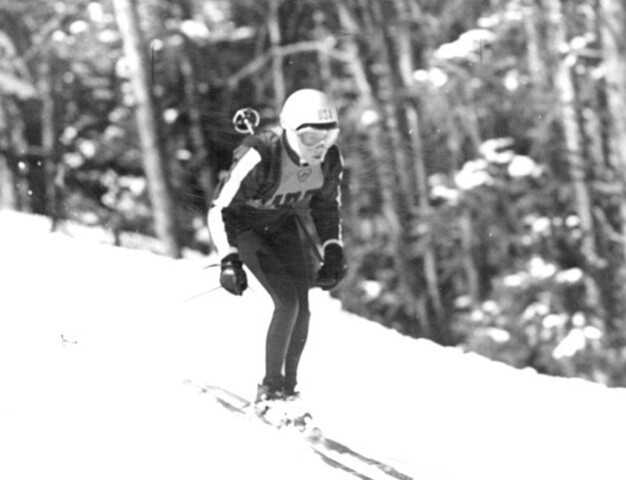
Saubert’s debut in the Olympics got off to a rocky start. The opening round of women’s slalom, she placed sixth. But she made up considerable ground in the second and final rounds to secure the bronze medal. In the women’s giant slalom, Saubert gave another solid performance, earning a silver medal.
After the Olympics, Saubert moved to Salt Lake City to train with Melville at the University of Utah. Though not born into the Church, Saubert had a few LDS friends growing up and knew about Mormons. During this time, Melville’s parents opened their home to Saubert, allowing her to stay with them while training. Saubert had studied quite a few religions in her life, and she took the opportunity to ask the Melvilles questions about the Church and the gospel they lived in their daily lives.
Later, she agreed to take the missionary discussions and accepted the challenge to be baptized. Her coach, Marvin Melville, performed the ordinance.
Both Melville and Saubert went on to faithfully serve in many callings. Melville served as bishop of a married ward at the University of Utah and later as a member of the high council. Saubert served as a member of the Young Women's MIA athletic board and later as a temple ordinance worker, always keeping her faith as a principle focus of her life until her death on May 14, 2007.
Marsha Mark-Baird
The first time Marsha Mark-Baird ran competitively, she was in the sixth grade.
Growing up in Trinidad, she had participated in other races held in dead-end streets near her home. But that time was different. That time, her father would buy her a bicycle if she won her age group.
With that incentive in mind, Mark-Baird trained hard for the race. And when the race day finally came, she not only won her age group, she beat out all the boys in her neighborhood. After that, Mark-Baird learned if you want something, you have to work hard for it.
Though athletic and well-known for her javelin throw, Mark-Baird had never even heard about the heptathlon until a coach recruited her to train for one at Ricks College (now BYU-Idaho). Instead of one track and field event, a heptathlon includes seven: 100m hurdles, high jump, shot put, 200m, long jump, javelin throw, and 800m. This meant Mark-Baird had to learn how to do hurdles, shot put, and high jump.

Marsha Mark-Baird, second from the right, competing at the 2004 Athens Games.
It was a steep and difficult learning curve, but within months, Mark-Baird was breaking school records. After two years she transferred to BYU, where she received a bachelor’s degree in 1997 and a master’s in social work in 1999.
Mark-Baird was first introduced to the Church after she enrolled at Ricks College. Though she liked many aspects of the gospel, Mark-Baird struggled with the idea of having a living prophet on the earth. “For five years I struggled with this, and after wondering about it and searching for answers, I finally decided to pray about it with a sincere heart,” she writes on her Mormon.org profile. “I found what I was looking for, the gospel of Jesus Christ. I received a clear, undeniable answer that the Church was true through the Holy Ghost.”
In 2000, after being baptized into the Church, , Mark-Baird made history as the first athlete from Trinidad and Tobago to compete in the heptathlon, where she placed 22. In 2004, she competed again, this time in the 2004 Athens Olympics where she placed 25.
Shortly after, Mark-Baird retired to start a family. She and her husband now have three little boys.
“My husband and my three kids are my universe,” Mark-Baird writes on Mormon.org. “I try to make sure their needs are being met as a wife and a mother. I sometimes fall short but know I can try again tomorrow. I also know that I can always work a little harder to be a good wife and mother.
“As an athlete I have learned to never give up even when it seems impossible. With the Lord on my side, all things are possible as long as I'm doing my part in sync with His plan. . . . I am not perfect, but through Him I gain my strength to try a little harder each day.”
Now that her three little boys are growing up, Mark-Baird recently came out of retirement to try for the 2016 Rio Olympics, but ultimately he didn’t qualify.
However, later this fall she hopes to break a record for women over 40 when she competes in the World Championship in Australia.

